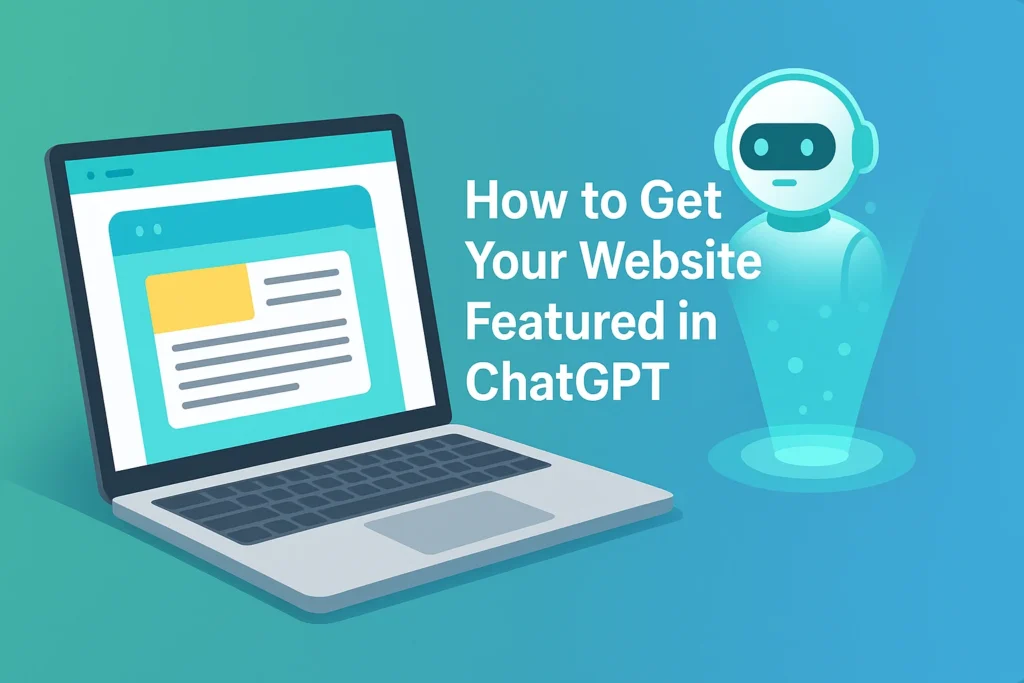Have you ever asked ChatGPT a question and noticed it sometimes references websites, quotes sources, or gives information from online articles? And then you wondered: “How can I get my website featured in ChatGPT’s responses too?”

You’re not alone. In fact, this question is one of the top concerns among SEO experts, marketers, and bloggers in 2025. So let’s break it down—without the jargon, without the fluff—just a real conversation about what it takes.
Why Should You Care About Being Featured in ChatGPT?
Imagine ChatGPT as a giant AI-powered library, and your website is one of the books on the shelf. When someone asks a question, ChatGPT runs across its vast bookshelf, picks the most trusted, well-written, and relevant book, and reads out an answer.
Now here’s the golden question:
How do you make your “book” the one ChatGPT chooses first?
That’s exactly what this guide is here for.
Step 1: Understand How ChatGPT Fetches Website Info
ChatGPT (especially GPT-4 and GPT-4.5) doesn’t search the internet in real time by default. Instead, it has a knowledge cutoff (like April 2024 or June 2025, depending on the model).
However, in browsing mode or through integrations (like Bing search or plugins), it can pull real-time info from the web. And when it does, it prefers authoritative, well-indexed sites.
In short:
- It remembers high-authority content from before its cutoff.
- It uses live browsing tools to reference current info.
- It shows preference to indexed, trusted, and high-quality content.
Step 2: Get Your Content Indexed—Fast
This is like getting your book into the library system.
If your content isn’t indexed by Google, Bing, and other engines, ChatGPT can’t access it.
Checklist:
- Submit your sitemap to Google Search Console & Bing Webmaster Tools
- Avoid using
noindexor blocking important pages in yourrobots.txt
Pro Tip: Use social sharing or backlinking to speed up the crawl. The more your content is talked about, the faster it gets discovered.
Step 3: Build EEAT into Your Content (Google loves it, ChatGPT respects it)
E-E-A-T stands for:
- Experience
- Expertise
- Authoritativeness
- Trustworthiness
And yes—ChatGPT considers these principles when selecting sources to surface.
Imagine your site is applying for a job. EEAT is your resume.
How to improve EEAT:
- Add author bios with credentials
- Use HTTPS and display trust signals
- Cite your sources and include outbound links
- Show real-life experience (case studies, photos, reviews)
Example: If you’re writing about fitness, ChatGPT is more likely to trust:
A certified trainer’s blog with personal stories and references
…than an anonymous site with generic, AI-generated content.
Step 4: Create Conversational, In-Depth, Human-Like Content
Yes, ironically—AI prefers human-written content.
Write like you’re talking to a friend. Mix short and long sentences. Use analogies (like this post does). Structure your content with:
- H1, H2, H3 tags
- Bullet points
- FAQs
- Table of Contents
- Internal and external links
Avoid robotic or keyword-stuffed writing.
Remember, AI is trained to detect and avoid spammy or shallow content.
Step 5: Earn High-Quality Backlinks & Mentions
Backlinks = votes of confidence.
When trusted websites link to you, it’s like being recommended by the popular kids in school. Google notices. Bing notices. And yes, ChatGPT notices too.
Ways to build backlinks:
- Guest posts on reputable blogs
- Be cited in industry roundups or interviews
- Use HARO (Help A Reporter Out)
- Publish original research or data studies
Rule of thumb: If your content gets backlinks from news sites, .edu, .gov, or trusted blogs, your chances of being referenced by AI go up.
Step 6: Track Mentions & Optimize for ChatGPT/Bing
If your website is already being cited on Bing search or Microsoft Copilot, there’s a good chance ChatGPT (especially in Bing Chat or GPT-4 with browsing) can reference it.
Check if you’re being mentioned:
- Use tools like Ahrefs, SEMrush, or Brand24
- Monitor Bing search rankings
- Check logs or analytics for ChatGPT user-agent hits (if browsing mode is enabled)
Pro Tip: Add a section like “As Featured In” or “Mentioned By” with logos of media sites or partnerships—it increases perceived authority.
Bonus Tips: Use Structured Data & Schema Markup
Give Google and Bing a cheat sheet for your content.
With schema, you tell search engines:
- What your page is about
- Who wrote it
- When it was published
- Whether it’s a product, FAQ, article, or review
Structured data = neon signs saying “Pick me, pick me!” to search engines and AI.
Final Words: You Don’t Have to Be Big, Just Be Trustworthy
Getting your website featured in ChatGPT isn’t about size—it’s about value.
Think of ChatGPT as an ultra-curious reader.
If your website offers clear, trustworthy, engaging, and well-organized answers, it will likely become one of its go-to sources.
Yes, it takes time.
Yes, it requires consistency.
But in the AI-driven future, getting featured in ChatGPT is like getting a front-row seat to millions of queries.
So start optimizing today—and let your website become the answer everyone’s looking for.
FAQs
Not always. Most ChatGPT models use pre-trained data. However, when browsing tools or plugins are active (like Bing integration), it can pull real-time data.
Ensure your content is:
▫ Indexed by search engines
▫ High quality, human-written
▫ Backlinked by authority sources
▫ Structured with schema markup
▫ Written with EEAT principles
Only if it’s fact-checked, edited by humans, and offers real value. Low-quality or spammy AI content can hurt your chances.
There’s no direct notification yet. But if you monitor Bing search mentions, user behavior, or use brand monitoring tools, you may spot AI-driven referrals.
Focus on usefulness, not just length. Long-form articles (1000+ words) with in-depth answers, FAQs, and structure perform better in ChatGPT responses.